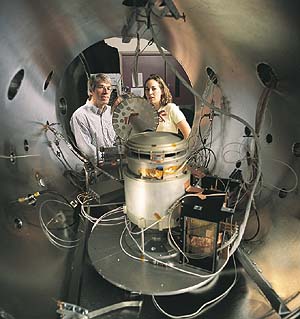 |
 |
| CURRENT ISSUE |  |
PAST ISSUES |  |
SEND A LETTER/NEWS |  |
ADDRESS UPDATE |  |
ADVERTISE |  |
ABOUT US |  |
ALUMNI HOME |
Features
Here Comes the SunPage 2 of 4
A UNH space science team is currently working on an instrument for NASA's next major solar mission. Known by the acronym PLASTIC (Plasma and Suprathermal Ion Composition), this instrument is designed to analyze the protons, alpha particles and heavy ions carried in the solar wind. It is part of a package of four sensors that make up NASA's Solar-Terrestrial Relations Observatory (STEREO), scheduled for launch in 2005. STEREO's other instruments will be provided by the University of California at Berkeley, The Naval Research Laboratory in Washington, D.C., and the Centre National de la Recherche Space Scientifique Observatory in Paris, France.
Actually, the UNH team is working on two PLASTIC instruments, because the STEREO mission involves two satellites equipped with identical sets of sensors. They will orbit the sun at the same distance as Earth, with one positioned well ahead of Earth and the other well behind. This will give scientists their first three-dimensional view of the sun and their first good look at the complex contortions of gas and magnetic fields associated with coronal mass ejections (CMEs), enormous eruptions that can hurl 10 billion tons of plasma into space at speeds exceeding 2 million miles per hour.
"We are especially interested in looking at solar wind explosively released from the sun as CMEs," explains Antoinette (Toni) Galvin, an associate research professor in the physics department and the Institute for the Study of Earth, Oceans and Space. "These eruptions are known to be a primary cause of space weather on Earth. We'll also be looking at other particles in space, including material that comes from outside the solar system." Galvin is the principal investigator for the PLASTIC project. It's her job to administer the $7 million budget and coordinate the activities of everyone working on the instrument. That's no small task, since pieces of PLASTIC are being built not only at UNH, but also at the University of Bern in Switzerland and the Max Plank Institute for Extraterrestrial Physics and the University of Kiel, both in Germany. NASA's Goddard Space Flight Center in Greenbelt, Maryland, is also a partner in the project, helping to test and calibrate the components.
 Research scientist Mark Popecki '91G and physics major Katherine Singer '03 test PLASTIC components in a cauum chamber in a Morese Hall laboratory. Photo by Perry Smith/UNH Photography Services |
The completed PLASTIC instruments will look something like large, ungainly cameras perched on top of the STEREO satellites. Each instrument will be about the size of a portable television set, weighing about 30 pounds, and will draw only 10 watts of power, provided by the satellite's solar panels. Fitting all of the project's science requirements into a package that small is quite a challenge, Galvin points out. Sitting at the desk in her small office on the fourth floor of Morse Hall, she opens a book of schematic drawings of various pieces of the instrument. "Each of these components is custom-made," she says. "You can't pull them off the shelf. They have to be designed for the specific experiment and for the space environment, so almost by necessity, they tend to be one of a kind."
Right now, the PLASTIC team at UNH--a total of about 20 scientists, engineers, technicians and students--is designing, building and testing those components. "The scientists know what they want to measure and can conceptualize a way to do it, but the engineers really make it work. A lot of the inventing comes from the engineers," Galvin explains.
Some of that inventing is being done by students. Four undergraduates are currently working on the project, experimenting with alternative solutions to particular engineering problems, looking at the performance of PLASTIC components in computer simulations, or testing engineering models in a vacuum chamber in the space science lab. "These students are actively involved with important design elements. This is not a paper project for them," Galvin emphasizes. "What they help us to design will fly in space."
Page: < Prev 1 2 3 4 Next >Easy to print version

